Our cats are felons. We don’t trust them to conduct themselves properly outside the premises of our flat apartment. Therefore, we keep them locked up at all times. And, besides a few short escapades that ended in scaredly scurrying back up the stair well, they seem to have resigned to their indoors existence. Yet, their intense staring (and tail-wagging) at birds at the other side of the window reminds us that they are not, by nature, indoor creatures.
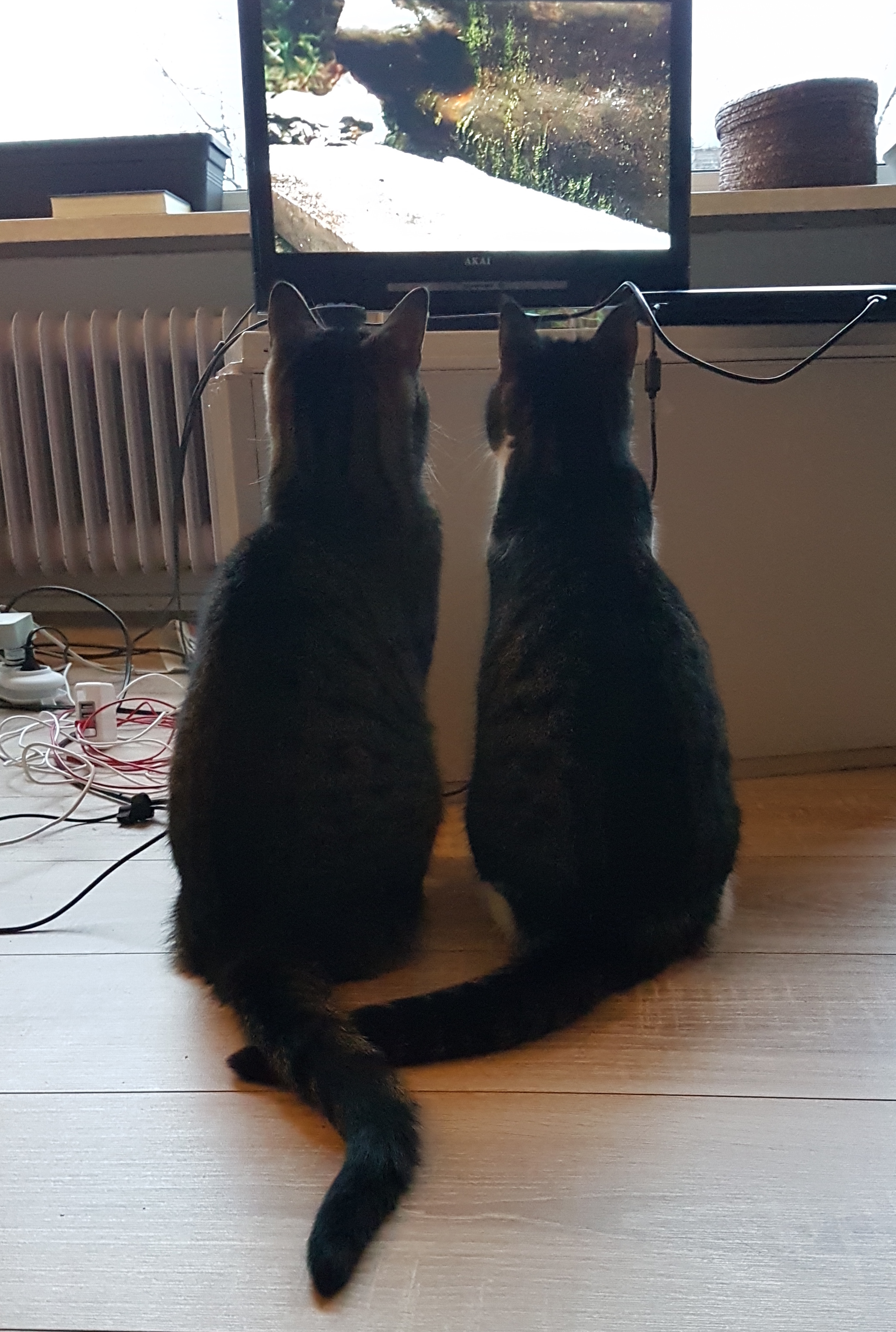
Exercising the beast
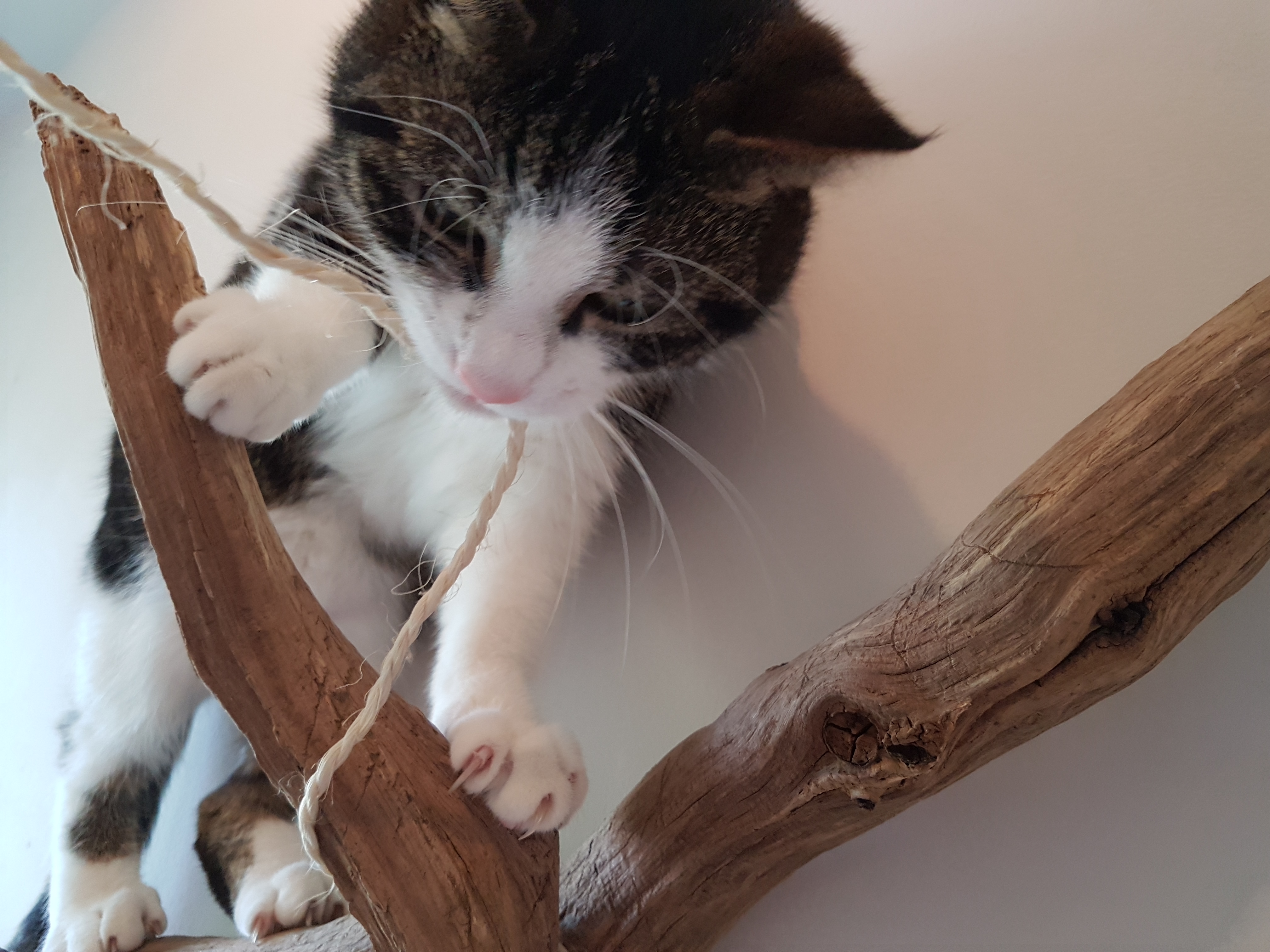
I can think of 3 ways in which the indoor cat’s inner beast can get frustrated: ❶ when its hunter-killer instinct is frustrated; ❷ when there are no grassy leafs to get that slimy hairball out their stomach and onto our bed sheets; or ❸ if it can’t scratch, climb, and recline in trees. ❹ Flossing is also important.
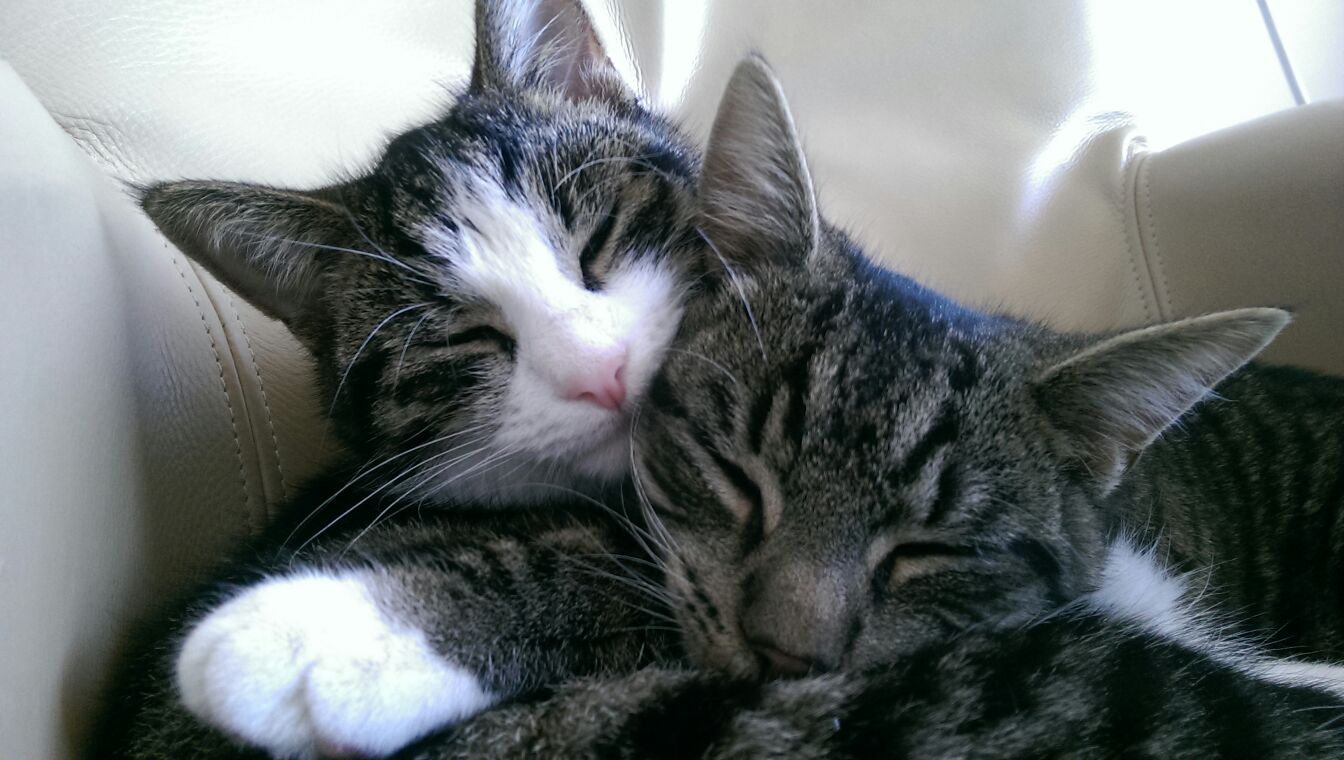
Cats are asocial creatures in the wild, where they live in family groups sometimes, but never hunt together. They may not be cooperative hunters, but I have known domestic cats—a bunch that used to live with my mother—to gang up on other cats; so there is that so-recognizable tribal element to them. Dinkie and Knabbel are not from the same nest; Knabbel is a few months older, but from the moment Dinkie joined our family group, they’ve functioned as siblings. Even now, at 3+ years old, they insist on running after each other like maniacs and play-fighting regardless of whether the other is actually play-fighting back or … just fighting, trying desperately/angrily to get the other off their back. You can debate the overal intelligence of cats, and we suspect Dinkie to be significantly smarter than Knabbel, but you cannot debate their social intelligence; there’s just nothing there to debate; their clear disregard for each other’s intentions is too absolute to be explained away by their egotistic psychopathy.
Knabbel and Dinkie are thoroughly domesticated; their infantile behaviours have persisted into adulthood, making them great companions also for us humans, with their regular begging for attention and overall cuddly demeanors. Their intra- and inter-species social behaviour is so un-wild-like that I wouldn’t rate is as necessary to keep their inner wild cat from growing frustrated; but let me number it ⓿, because they do appear to cherish all the attention from us and from each other. In a sense we truly are the mother and father of cats, because our kitten remained kittens towards us.
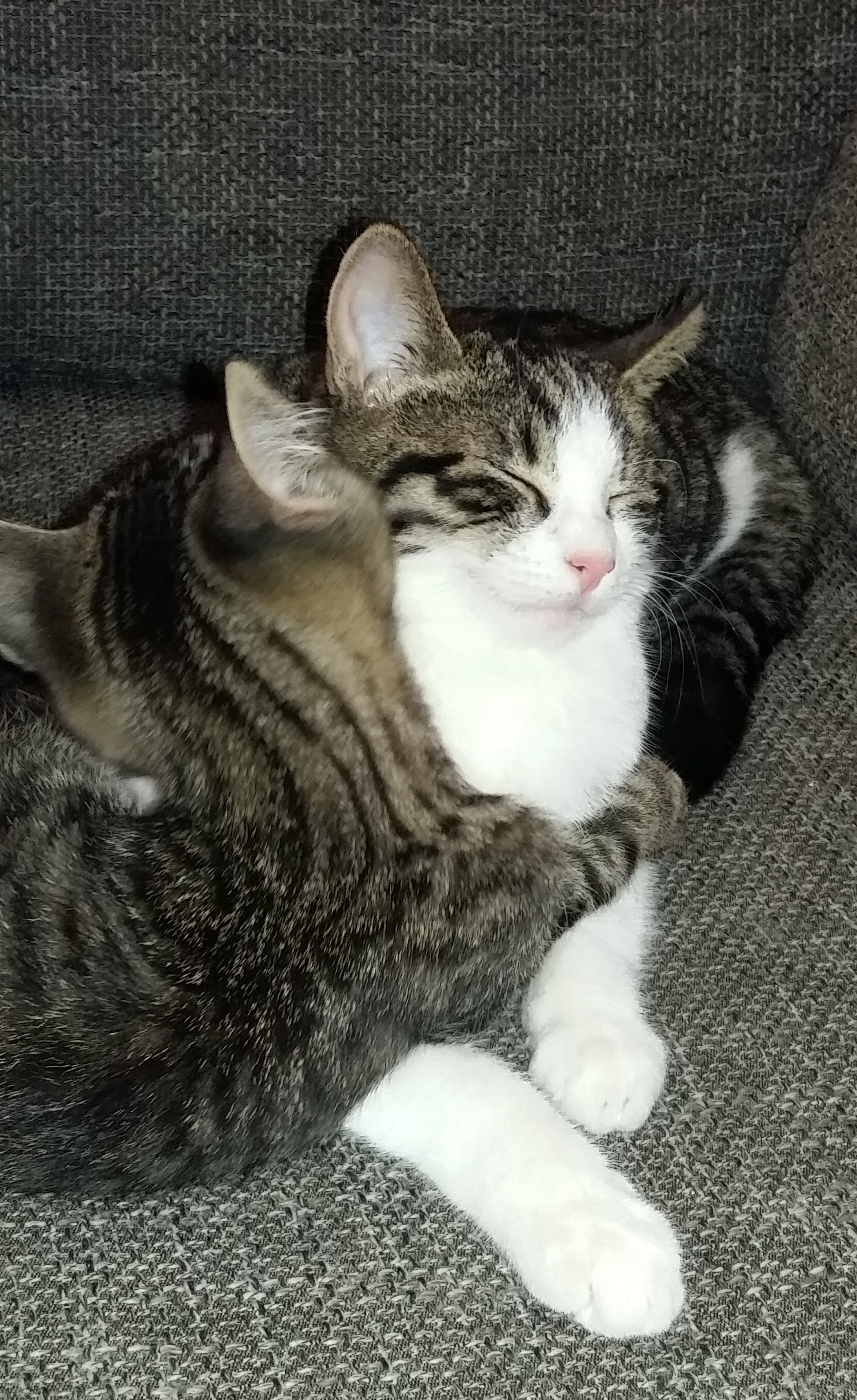
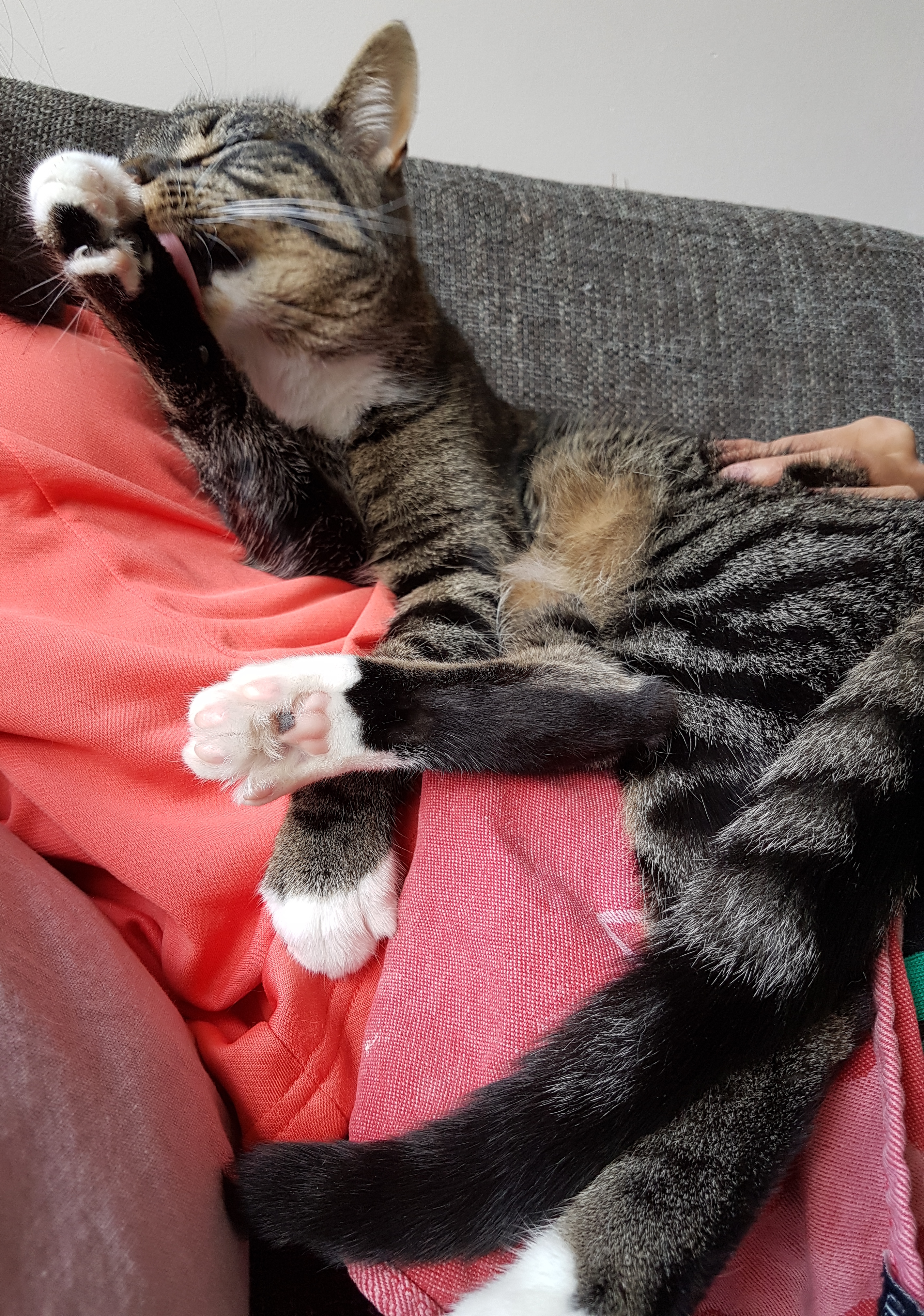
❶ Hunters and killers ☐
For all their cuddly exterior (and their purring, and their cute, little head bunts), what cats like to do most is to cuddle a crunchy little bird to death between their cute cat teeth. Cats can be cute to their owners, but they are horrible in the way that they torture their prey before finally granting them the mercy of the kill.
But not our cats. They only get to torture the occasional spider or insect, which they then take their sweet time for. We’ve come to know the macabre meaning of both Dinkie and Knabbel looking with fascination at the same spot on the floor: something is struggling for its life. The horrible truth? We find this cute. These murderous machines make us make baby sounds.
Regarding the joy they’d take in hunting and killing, there’s little that we can do to help them experience this in our home. After toying with the idea for a year or two and just getting raised eyebrows, last year I did finally end up loosing some baby frogs in the bathroom, and locking them in there with Dinkie. That was a mistake. One of the frogs was stressed to death. The other was slightly damaged and in pretty bad shock. Dinkie ate neither. As soon as their desperate hopping became less enthusiastic, he lost interest. The whole scene made me feel horrible, and I set free the surviving frog next to a nearby ditch, hoping that it would miraculously survive and mix with the local frog population. (We took the frogs from 10 km south of the city.)
After having resigned to the fact that we cannot match our cats on The Hare Psychopathy Scale, the closest we let them get to murdering prey is playing with little balls, wires and what not to let them at least practice their prowl and attack. Dinkie used to likes to play fetch the victim with a little ball. These days he prefers that I run after the ball, while he shuffles around in the middle, trying out different angles for his ambush; then when I throw, he jumps as high as possible to grab the ball out of the air. Disemboweling stuffed toys (or, even better, bundles of socks) is ranked higher as a pastime for Knabbel. They both get equally lit up when the laser dot is activated, each in their own way:
- Tap-dancing with his front paws best describes what Dinkie does when you move the laser dot back and forth in front of him. That, or sprints, intertwined with stalking the dot from behind ridiculously bad camouflage.
- Knabbel stalks and sprints after the laser dot with a bit less—much less—tension. She does most everything with less tension. When she gets the crazies—when she’s not just blisfully snuggling somewhere, and, yes, she does get the crazies—she’ll transform into a sort of furry pinball, bouncing off of walls, doors and whatever can help her to abrubtly change direction without losing momentum.
Knabbel’s racing vehicle of choice would be beefed-up destruction derby car. Dinkie would prefer a batmobile. He is as precize in his movement as Knabbel is nonchalant. Because ‘mom’ and ‘dad’ are often otherwise occupied, most of their daily chasing practice comes from adjusting to each other’s disparate attack and counter-attack styles. From the moment that Dinkie entered Knabbel’s life, he has been able to sneak up on her while she was actively chasing him. When she does spot him, she’ll storm right through him.
❷ Grass eaters ☑
Felis catus is an obligate carnivore, meaning that they don’t digest plant material well. Why then do they insist on eating up so many of our precious house plants? Why, I ask you in particular, Dinkie?!
To keep Dinkie his greedy little mouth out of certain plants—especially seedlings—and his his proud little anus out of the nice, loose pot soil, we riddle the pots with skewers and upturned forks. This helps, to some extent.
We hoped that cat grass—I haven’t determined the variety the garden center sells to us—would shift their attention away from the rest of the plants in our apartment. They love it, even when it’s all dry and hay-like. They eat it more enthusiastically than the rest of our plants, but, alas, Dinkie likes a varied diet. And not just that, he also likes to pull plants—root and all—out of their pots, using his nails as hooks. Thus we’re stuck with lots of skewery, pointy things in our pots. (He’ll chew on that as well, mind you.)
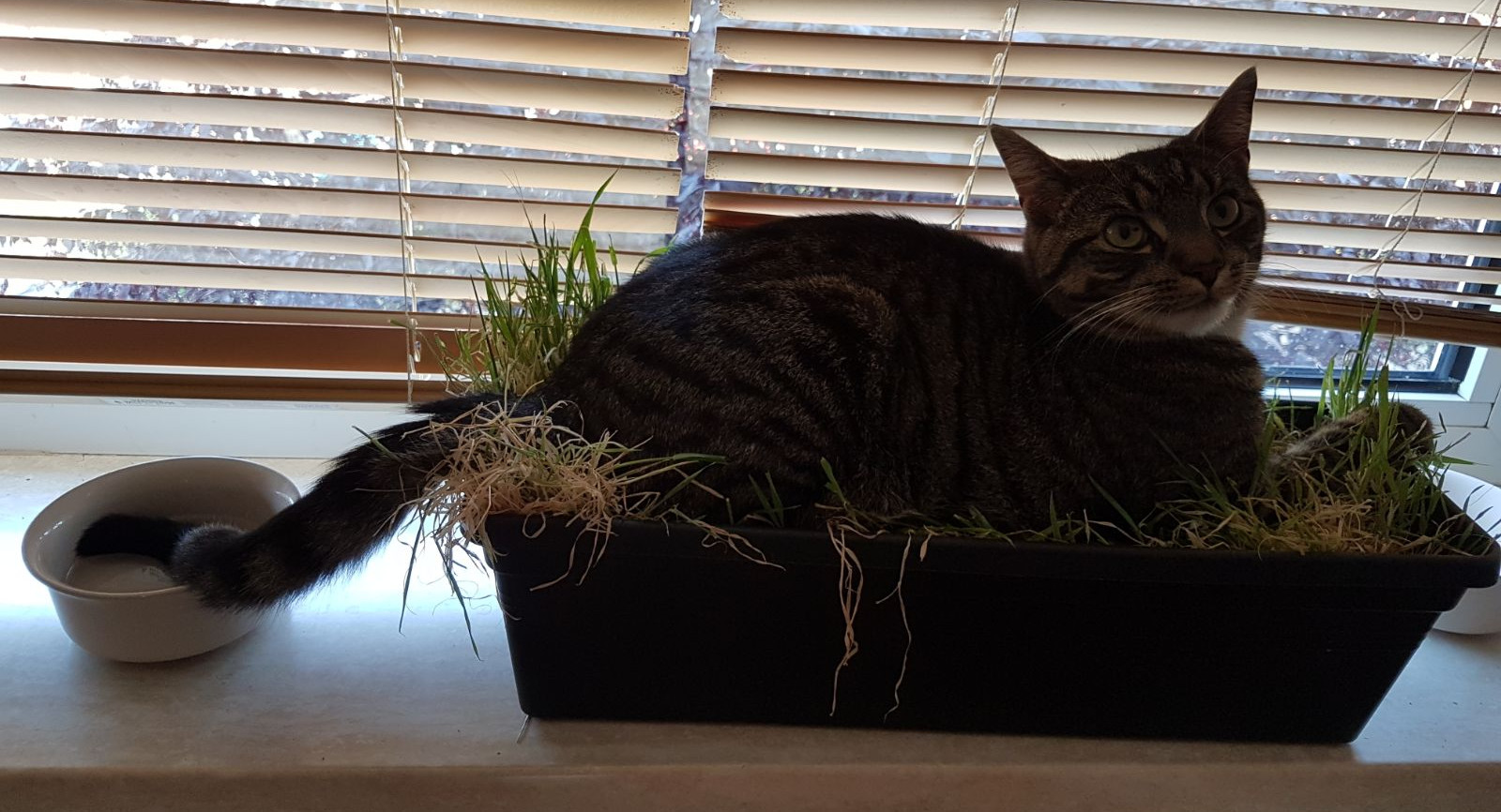
❸ High climbers ☑
Cats like to climb. They feel safest in high places. The wild ancestors of Knabbel and Dinkie spent a lot of their time in trees. There are trees growing in front of and in the back of our apartment. These trees even host birds. Yet, overprotective helicopter cat parents that we are, we never let them go outside. Instead, I fabricated a toy tree of sorts from the dry, mangly heartwood of oak.
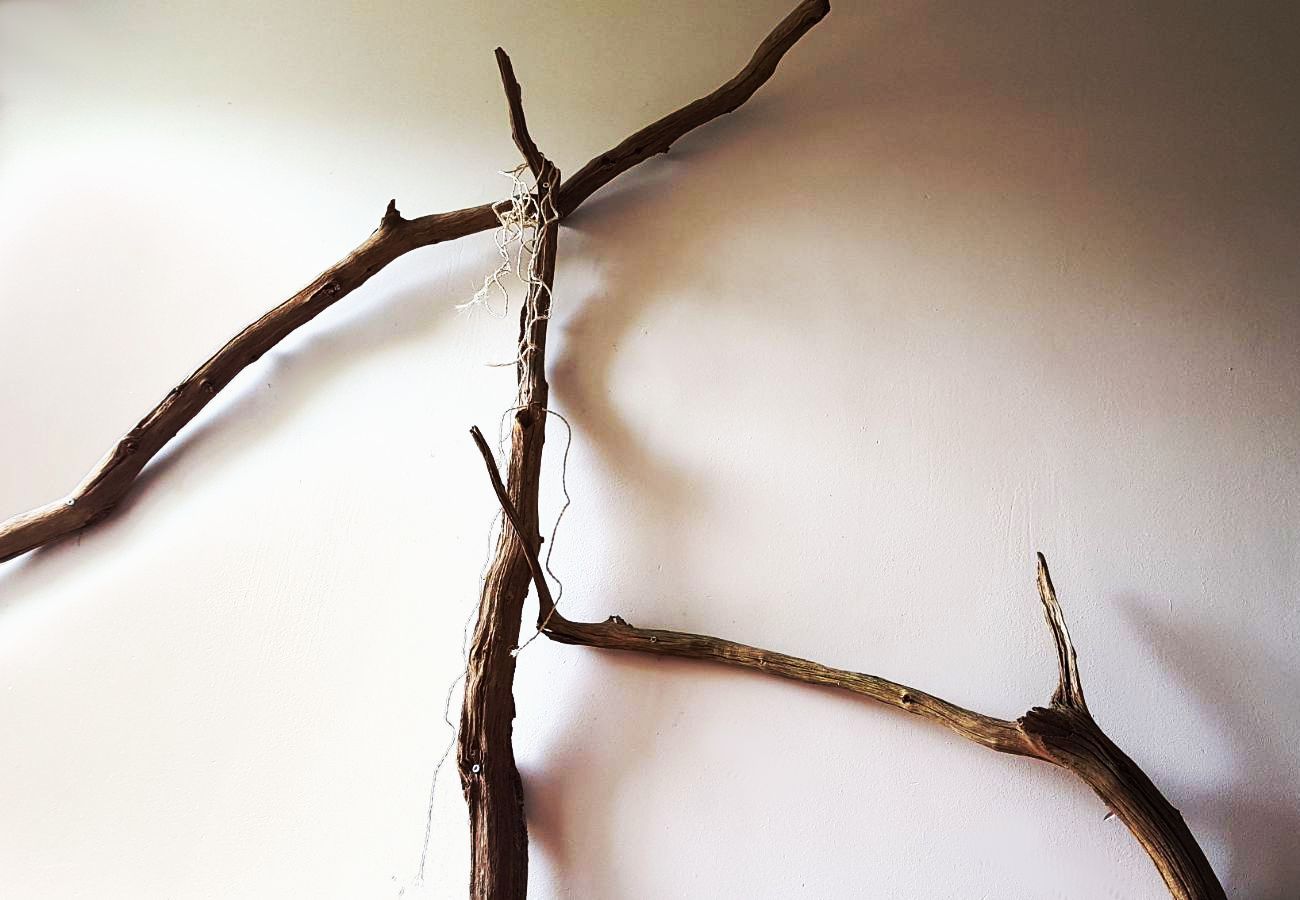
Initially, both Dinkie and Knabbel didn’t dare to climb (hardly even scratch) the thin, hard branches. This was sort of what I hoped for. I was hoping to give them something exciting to do when we were away from the apartment. Knabbel, who’s much more daring—I might as well say: wildly uncautious—than Dinkie, was the first to jump onto the various branches of their gnarly, slippery indoor tree. Her front shoulders are strong; when she loses grip on the narrow, hardwood and is hanging on by her front paws alone, she usually manages to scramble back up. When she does fall, she’ll be right back on the top branch.
Compare that to Dinkie, who, when he finally started climbing the ‘tree’, kept out of it for months when just once I wasn’t there in time to catch his nervous, little self, when he was hanging on by his front paws, insufficiently strong to get himself back on the branch. Meanwhile, his front legs have grown in strength (perhaps in part due to his currently favorite game: “ambush the ball”). I’ve seen him also pull himself up using his front body. At the moment—July, 2019—Dinkie climbs more often than Knabbel; he’s feeling sufficiently confident and in control that it’s become an almost nightly ritual for him when I bed down, so that I can enjoy the scene in the branches from below.
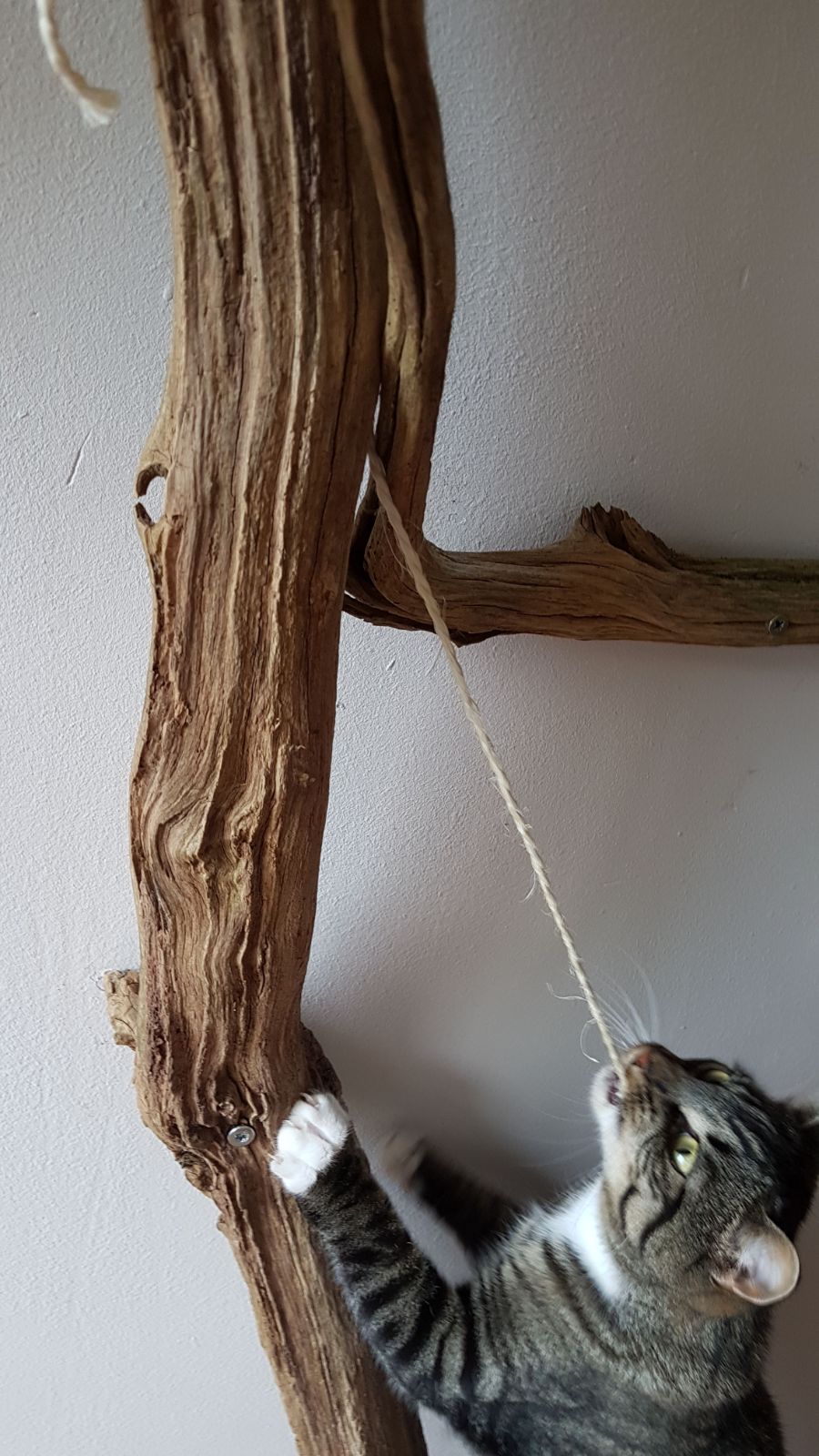
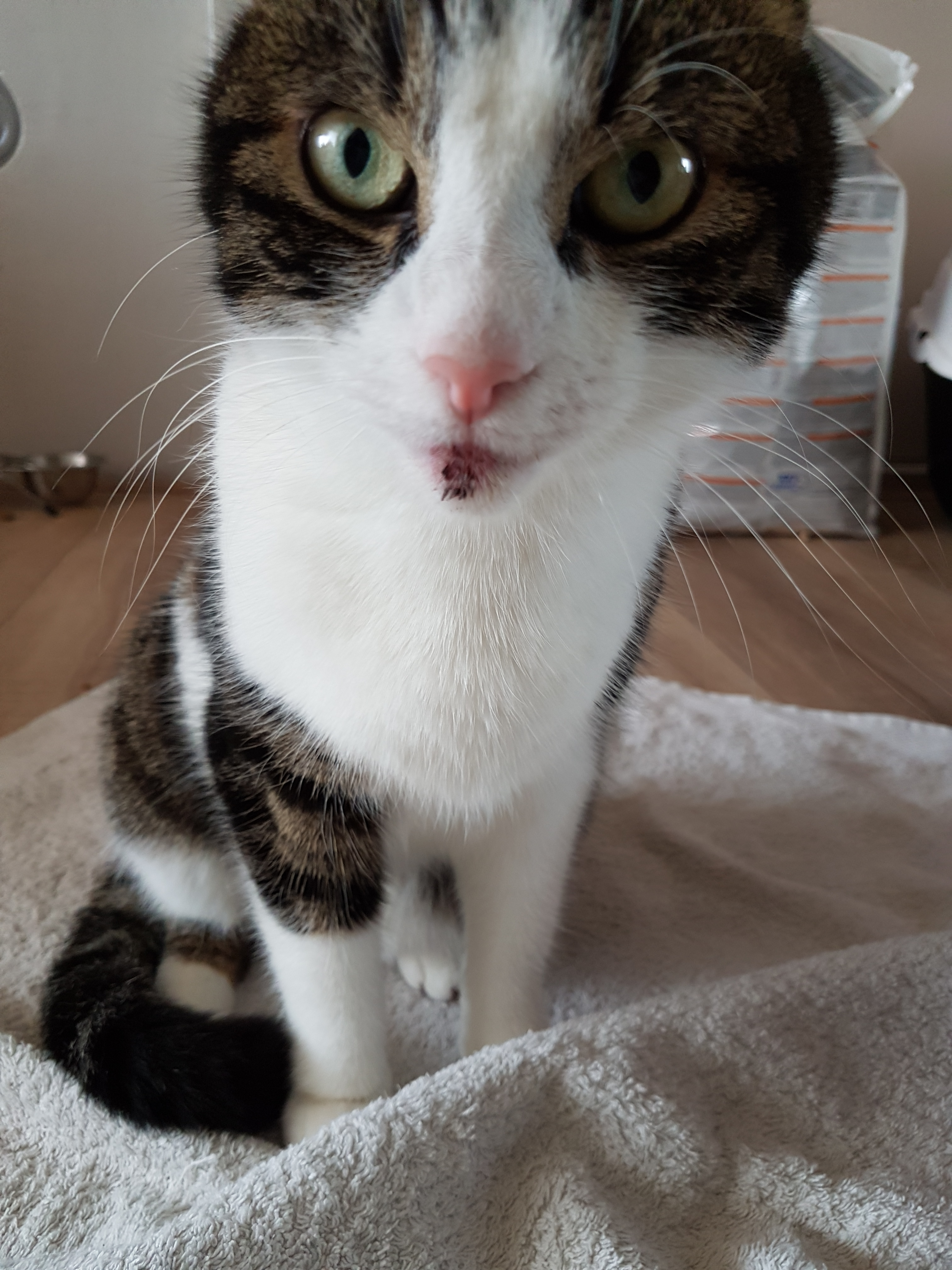
When I’m laying below my indoor climbing construction for cats, I’m often reminded of how proud I am of this project. The reasons why are numerous:
- The gnarly, dry, oak heartwood looks pretty—pretty enough that it has been mistaken for a wall decoration. Well, it is a wall decoration, but it’s a… Alright, it’s a decorative cat toy.
- The branches are from an unused heap of heartwood in my father’s terrain (“De Oude Molensteen”). I’m proud to have a father who has these kinds of collections, and he and his home-made nature reserve—“De Oude Molensteen”—will star in many articles to come.
- Speaking of my father, he was always “going to” build these cool things for his kids. Sometimes he followed through. As he got deeper and deeper into a losing company, this became increasingly rare. I recognized this pattern in myself as a cat dad (except that I had always been all talk and no play): as soon as Marilisa and I convicted our first cat to an indoor existence, I started thinking (and talking) about making some kind of climbing construction with wood from the forest; it took me a good year or so to actually follow through. But, darn, did it feel good to turn potential into actuality and to look at the finished result. Now I was not just this great cat dad in theory—in some hypothetical future with unlimited time…
- The branches are narrow and hard—in other words: difficult to negotiate; if you have claws; you’re going to have to use them. Even when driving with your nails strongly, one or two paws will often slip away. That’s when the cats get to practice their pull-ups.
- I transported the oak cores (+ some long screws & plugs) home by bicycle cart/trailer. We don’t have a car. We don’t want to have a car. After all, ‘dad’ also needs his share of discomfort to stay healthy and happy. Comfort breeds laziness breeds weakness breeds discontent breeds more comfort breeds more weakness, ad nauseam, until the discomfort can no longer be bought off by more luxury.

❹ Don’t forget to floss ☑
I could have grouped plucking under Hunters and killers. Yet, their—especially Dinkie’s—urge to run rope through their teeth seems separate from the chase and kill. Marilisa often exclaims how uncomfortable it seems when they’re pulling apart rope with teeth and gum, and I think that that is precisely the point. It must feel awful, and they love it. If they don’t love it, they at least need it to stay sane and not too tame.
Just like the naked ocelot in Howard Bloom’s story. His story made clear to me that there’s an animal in each of our brains, and that that animal needs exercise to stay healthy. He tells of a naked ocelot that kept destroying its own until the zoo provided him with the discomfort of actual feathers to pluck. His food had been too easy to process, frustrating his instinct of having to deal with mouthfuls of annoying feathers that got into his nose and everywhere to make him miserable. Once that essential misery was provided, the beast’s fur was soon restored to its full, healthful glory.
Beware of being too comfortable too often for too long!
